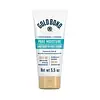What's inside
What's inside
 Key Ingredients
Key Ingredients

 Benefits
Benefits

 Concerns
Concerns

 Ingredients Side-by-side
Ingredients Side-by-side

Water
Skin ConditioningGlycereth-26
HumectantPEG-40 Hydrogenated Castor Oil
EmulsifyingHamamelis Virginiana Water
AstringentNiacinamide
SmoothingAmmonium Acryloyldimethyltaurate/Vp Copolymer
Coco-Caprylate
EmollientPentaerythrityl Tetraisostearate
EmollientPhenoxyethanol
PreservativeTrideceth-9
EmulsifyingBisabolol
MaskingPEG-5 Ethylhexanoate
EmulsifyingPanthenol
Skin ConditioningRosmarinus Officinalis Leaf Oil
MaskingLavandula Angustifolia Oil
MaskingBenzoic Acid
MaskingDehydroacetic Acid
PreservativeEthylhexylglycerin
Skin ConditioningChamomilla Recutita Flower Oil
MaskingCitric Acid
BufferingSodium Carrageenan
Emulsion StabilisingZingiber Officinale Root Extract
MaskingSea Salt
AbrasiveLimonene
PerfumingLinalool
PerfumingWater, Glycereth-26, PEG-40 Hydrogenated Castor Oil, Hamamelis Virginiana Water, Niacinamide, Ammonium Acryloyldimethyltaurate/Vp Copolymer, Coco-Caprylate, Pentaerythrityl Tetraisostearate, Phenoxyethanol, Trideceth-9, Bisabolol, PEG-5 Ethylhexanoate, Panthenol, Rosmarinus Officinalis Leaf Oil, Lavandula Angustifolia Oil, Benzoic Acid, Dehydroacetic Acid, Ethylhexylglycerin, Chamomilla Recutita Flower Oil, Citric Acid, Sodium Carrageenan, Zingiber Officinale Root Extract, Sea Salt, Limonene, Linalool
Water
Skin ConditioningHydroxyethyl Urea
HumectantCaprylic/Capric Triglyceride
MaskingDimethicone
EmollientGlycerin
HumectantStearyl Alcohol
EmollientVitis Vinifera Seed Oil
EmollientGlyceryl Stearate
EmollientSodium Hyaluronate
HumectantCeramide NP
Skin ConditioningGluconolactone
Skin ConditioningSteareth-21
CleansingNiacinamide
SmoothingGuar Hydroxypropyltrimonium Chloride
Skin ConditioningCholesterol
EmollientCeramide Ns
Skin ConditioningPolysorbate 60
EmulsifyingEthylhexylglycerin
Skin ConditioningPanthenol
Skin ConditioningCeramide EOP
Skin ConditioningCaprooyl Phytosphingosine
Skin ConditioningPolyacrylate Crosspolymer-6
Emulsion StabilisingCeramide Eos
Skin ConditioningHydroxyacetophenone
AntioxidantCetyl Alcohol
EmollientCeramide AP
Skin ConditioningCaprooyl Sphingosine
Skin ConditioningTocopherol
AntioxidantCetearyl Alcohol
EmollientDisodium EDTA
Ceteareth-25
Cleansing3-O-Ethyl Ascorbic Acid
Skin ConditioningBehenic Acid
CleansingWater, Hydroxyethyl Urea, Caprylic/Capric Triglyceride, Dimethicone, Glycerin, Stearyl Alcohol, Vitis Vinifera Seed Oil, Glyceryl Stearate, Sodium Hyaluronate, Ceramide NP, Gluconolactone, Steareth-21, Niacinamide, Guar Hydroxypropyltrimonium Chloride, Cholesterol, Ceramide Ns, Polysorbate 60, Ethylhexylglycerin, Panthenol, Ceramide EOP, Caprooyl Phytosphingosine, Polyacrylate Crosspolymer-6, Ceramide Eos, Hydroxyacetophenone, Cetyl Alcohol, Ceramide AP, Caprooyl Sphingosine, Tocopherol, Cetearyl Alcohol, Disodium EDTA, Ceteareth-25, 3-O-Ethyl Ascorbic Acid, Behenic Acid
 Reviews
Reviews

Ingredients Explained
These ingredients are found in both products.
Ingredients higher up in an ingredient list are typically present in a larger amount.
Ethylhexylglycerin (we can't pronounce this either) is commonly used as a preservative and skin softener. It is derived from glyceryl.
You might see Ethylhexylglycerin often paired with other preservatives such as phenoxyethanol. Ethylhexylglycerin has been found to increase the effectiveness of these other preservatives.
Niacinamide is a multitasking form of vitamin B3 that strengthens the skin barrier, reduces pores and dark spots, regulates oil, and improves signs of aging.
And the best part? It's gentle and well-tolerated by most skin types, including sensitive and reactive skin.
You might have heard of "niacin flush", or the reddening of skin that causes itchiness. Niacinamide has not been found to cause this.
In very rare cases, some individuals may not be able to tolerate niacinamide at all or experience an allergic reaction to it.
If you are experiencing flaking, irritation, and dryness with this ingredient, be sure to double check all your products as this ingredient can be found in all categories of skincare.
When incorporating niacinamide into your routine, look out for concentration amounts. Typically, 5% niacinamide provides benefits such as fading dark spots. However, if you have sensitive skin, it is better to begin with a smaller concentration.
When you apply niacinamide to your skin, your body converts it into nicotinamide adenine dinucleotide (NAD). NAD is an essential coenzyme that is already found in your cells as "fuel" and powers countless biological processes.
In your skin, NAD helps repair cell damage, produce new healthy cells, support collagen production, strengthen the skin barrier, and fight environmental stressors (like UV and pollution).
Our natural NAD levels start to decline with age, leading to slower skin repair, visible aging, and a weaker skin barrier. By providing your skin niacinamide, you're recharging your skin's NAD levels. This leads to stronger, healthier, and younger looking skin.
Another name for vitamin B3 is nicotinamide. This vitamin is water-soluble and our bodies don't store it. We obtain Vitamin B3 from either food or skincare. Meat, fish, wheat, yeast, and leafy greens contain vitamin B3.
The type of niacinamide used in skincare is synthetically created.
Learn more about NiacinamidePanthenol is a common ingredient that helps hydrate and soothe the skin. It is found naturally in our skin and hair.
There are two forms of panthenol: D and L.
D-panthenol is also known as dexpanthenol. Most cosmetics use dexpanthenol or a mixture of D and L-panthenol.
Panthenol is famous due to its ability to go deeper into the skin's layers. Using this ingredient has numerous pros (and no cons):
Like hyaluronic acid, panthenol is a humectant. Humectants are able to bind and hold large amounts of water to keep skin hydrated.
This ingredient works well for wound healing. It works by increasing tissue in the wound and helps close open wounds.
Once oxidized, panthenol converts to pantothenic acid. Panthothenic acid is found in all living cells.
This ingredient is also referred to as pro-vitamin B5.
Learn more about PanthenolWater. It's the most common cosmetic ingredient of all. You'll usually see it at the top of ingredient lists, meaning that it makes up the largest part of the product.
So why is it so popular? Water most often acts as a solvent - this means that it helps dissolve other ingredients into the formulation.
You'll also recognize water as that liquid we all need to stay alive. If you see this, drink a glass of water. Stay hydrated!
Learn more about Water